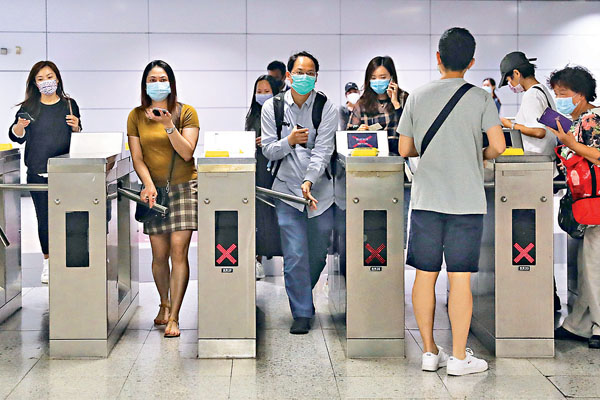
【原文】港鐵票價可加可減機制設立12年來,首次得出減幅,6月底起將減價1.7%。面對經濟逆境,本港的公共交通服務票價機制確實需要及時檢討調整,以更貼切地反映經濟環境和市民負擔能力的變化,體現公共交通票價機制照顧民生、讓市民得利的初衷。
港鐵6月底減票價1.7%,是設立可加可減機制以來首次減票價;遺憾的是,八達通乘客八折優惠4月1日起改為九五折優惠,八達通乘客實際上比現時要多付一成九車費。港鐵從2010年設立可加可減機制起,一直有加無減;而政府早前又批准多家巴士公司4月4日起加價一成左右,市民的總體交通成本勢必逆市上升。
事實上,同樣作為公共交通服務,港鐵和巴士公司的票價機制並不一樣。自從設立可加可減機制後,港鐵每年就按照運輸業名義工資指數、通脹數據等等,計算出一個票價的加幅或減幅,直接公布實施。而巴士公司只需按照自身經營情況來申請加價,而不用考慮社會整體通脹。這就是港鐵減價、巴士加價的區別所在。
不過,無論是何種方式,現在看來,公共交通都有全面檢討票價調整機制的必要,關鍵是要彰顯公共交通的社會服務屬性,要更多地考慮普羅市民的負擔能力。尤其是在經濟大環境不好的時候,公共交通的票價調整,更加要充分考慮市民的負擔能力,不能將經營壓力透過票價調整全數向市民轉嫁。
新冠疫情持續一年多,失業率升至7.2%的17年高位,26萬人淪為失業大軍,大量打工仔面對減薪或放無薪假,但在這樣的情況下,乘客的總體交通負擔竟然仍要增加,無疑是令市民百上加斤。
無論是港鐵還是巴士,都享受着不同形式的政府補貼。例如港鐵有車站上蓋的物業發展專營權、巴士則有隧道費優惠等等。既為交通政策的受惠者,理應在經濟困難時期作出更大承擔。
現時政府都想方設法為基層市民提供支援措施,如果公共交通只顧自身的經營情況,不減反加,顯然有違公共交通服務的初衷。如果公共交通服務可以不理民生苦況,那麼市民不禁要反問,政府在經濟困境下,是否應該將對公共交通的補貼扣減,改為直接補貼市民呢?
因此,政府有必要全盤檢討現行的公共交通票價機制。一方面在票價公式中加入不同的元素,除了消費物價指數外,還應該考慮工資中位數、市民負擔水平、失業率等關係到市民真實收入水平的元素;另一方面,對於坐擁大量優質土地的港鐵公司而言,更應該將物業發展收益加入公式,用賣樓收益補貼鐵路運營成本。
有立法會議員和學者均指出,目前公共交通票價的可加可減機制設計太簡單,應加入更多元素,例如可加入失業率、工資中位數加幅等反映市民經濟狀況的元素。政府應認真考慮、採納有關建議,改善公共交通的票價調整機制,平衡社會環境、企業經營情況和乘客需求,令票價調整更合理、更照顧基層市民的出行需要。 ( 摘錄自香港《文匯報》社評 2021-3-30)
Fare adjustment mechanism must factor in people's livelihood
【譯文】For the first time since the establishment of the MTR fare adjustment mechanism in 12 years, commuters can pay less for their train rides as fares are going down by 1.7 per cent by the end of June. In the face of an economic downturn, the fare adjustment mechanisms for public transport services in Hong Kong are in dire need to be reviewed. The adjustment mechanisms should take into account changes in economic realities and the affordability of the people, so as to stay on course of its original goal of attending to civic and social needs.
The MTR's impending fare cut in June will be the first since its fare adjustment mechanism was put in place. Regrettably, the 20 per cent discount for octopus card users will end on 31 March and be replaced with a mere 5 per cent discount. That means passengers using Octopus cards will actually have to pay 19 per cent more per trip after the change. Since the MTR fare adjustment mechanism was implemented in 2010, ticket prices have only been ever increasing. Considering that the government has just nodded for the fare hikes of multiple bus companies averaging nearly 10 per cent, transport costs for the public are set to go up amid the economic downturn.
Although the MTR and buses are both integral components of the local public transport, the formulae of their fare adjustment mechanisms are different. The MTR fare adjustment mechanism has always taken into account factors such as inflation rate and the nominal wage index of the transportation sector. Meanwhile, bus companies only need to take into account their own business performances when they file an application for fare hikes. The necessity to factor in socio-economic data in its fare adjustment mechanism is the reason why the MTR has to cut fares when bus companies can do the opposite.
Despite such differences, there is an urgent need for a complete review of all fare adjustment mechanisms of public transports. The key issue here is to highlight public transports as a public service, thus the affordability of citizens must receive a higher priority. This is especially important when the economy is sustaining downward pressure, as fare adjustment mechanisms cannot be used as tools for public transport operators to shift their burden to the public.
It has been over a year since the Covid-19 pandemic hit Hong Kong. The unemployment rate has now risen to a 17 year high at 7.2 per cent, with 260,000 people left without jobs and even more facing a pay cut or being forced to take unpaid leave. The overall transportation cost still going up given such difficult circumstances will undoubtedly make the people's lives harder.
To put it into perspective, both the MTR and the bus companies enjoy different forms of government subsidies. For example, the MTR has a franchise on all its above-station property development projects, while bus companies are given tunnel toll concessions. As the beneficiaries of the government's transportation policies, these public transport operators should make greater commitments when Hong Kong is facing economic difficulties.
The government is currently doing its best to provide support to the grassroots. If the public transport operators only care about their own businesses and increase fares instead of slashing them, they would be defeating their purpose of serving the people. When that happens, it is only natural for the public to ask why shouldn't the government's subsidy money go into their pockets directly instead.
Therefore, the government must review comprehensively the existing public transport fare adjustment mechanisms. On the one hand, the consumer price index and other factors that indicate the real income level of citizens, such as the median wage, the unemployment rate, and the general affordability of citizens, should be added to the formulae. On the other hand, revenue generated from the MTR's property development projects should be included in the rail operator's fare adjustment formula. Given that they are in possession of so many prime development sites, that revenue should be used to cover its rail operating expenses.
Some lawmakers and scholars have also made some similar criticisms in that the current design of the fare adjustment mechanism is too simple. According to them, more factors that can reflect the economic realities, such as the unemployment rate and the median wage, should be added to the formulae. The government should consider adopting these recommendations to refine the fare adjustment mechanisms and strike a balance between the socio-economic environment, business operations, and the needs of commuters. By doing so, a more reasonable adjustment mechanism can be achieved and the travelling needs of the grassroots can be better addressed.●Jeffrey Tse
Exercise
1. 工資中位數
2. 名義工資
3. 實質工資
4. 公共交通費用補貼計劃
5. 車站上蓋物業
Answer
1. median wage
2. nominal wage
3. real wage
4. the Public Transport Fare Subsidy Scheme
5. above-station property






0 / 255